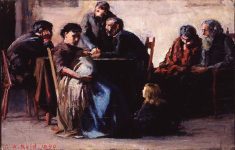Canola oil content
Further to “Canola oil content disputed” (WP, Dec. 3, 2015), the Canadian Grain Commission would like to provide clarification on the canola oil content data we publish.
Our data is based on averages; this means that there are canola oil content levels that are both higher and lower than the averages.
The weather during the growing season in Western Canada has an effect on canola oil content and it varies by province and crop district.
Read Also

Proactive approach best bet with looming catastrophes
The Pan-Canadian Action Plan on African swine fever has been developed to avoid the worst case scenario — a total loss ofmarket access.
Since 2013, we have published canola oil averages for each crop district that we have designated in Manitoba, Saskatchewan, and Alberta (including the Peace River area).
This information has been published annually as part of our harvest quality reports and is available online at www.grainscanada.gc.ca.
When reviewing our data, users shoud keep in mind that the data collected is based on clean canola samples and that dockage has been removed. Dockage dilutes the oil content of the samples. As an example, to consider the effect on 2 percent dockage, users should multiply clean oil content by 0.98 ({100-2}/100).
The Canadian Grain Commission takes concerns raised about the canola oil content data that we publish seriously. In the future, our preliminary canola harvest quality reports will be modified to include the oil content ranges in each province.
As part of our role in assisting in the promotion and sale of Canadian grain, we are committed to sharing our quality data with the industry.
For general inquires about the quality data we publish, users can consult our website or call 800-853-6705.
For questions about quality data on canola, users can contact Veronique Barthet at 204-984-5174.
Elwin Hermanson
Chief Commissioner
Canadian Grain Commission
Winnipeg, Man.
Another Wall selloff
In September 2007, Saskatchewan Party leader Brad Wall unequivocally stated that “crowns are not going to be privatized and (subsidiaries) are not going to be wound down.”
Yet here we are some eight years later, with Wall proposing the sale/giveaway of yet another Saskatchewan money maker, namely the Saskatchewan government liquor stores, while we, the taxpayer will be saddled with the problems that liquor abuse seems to be responsible for.
Wall has sold off dozens of jobs previously done by the crowns and their subsidiaries. For example, SaskTel alone contracted out or sold seven of its services.
SaskEnergy is forced to sell three of its subsidiaries to comply with Wall’s “Saskatchewan first.”
Never mind SaskPower’s carbon capture fiasco, SaskPower as well was forced to divest itself of assets that did not conform to Wall’s Saskatchewan first policy.
Under Wall’s tutelage, Saskatchewan Landing, Cypress Hills and Greenwater Lake provincial parks were sold/privatized. Cabin rental, as well as services such as clearing and maintaining hiking trails, firewood supplies, went to private sectors.
The Saskatchewan first policy was a thinly disguised policy adopted by Wall, whose purpose was to prevent government owned companies from competing against the private sector.
Under a premier who stated that crowns and their subsidiaries would not be privatized, Saskatchewan has sourced out more jobs than one can imagine.
Hospital laundry services went to Alberta, Saskferco went to Norway, power to Northland Power, Ontario, and on and on.
Now Wall wants to privatize more than Saskatchewan government liquor stores.
Every one of these stores employs several people who shop local, enrol their children in local schools, pay taxes to the community and partake in local churches, organizations and sports. These will be gone.
The local grocery store will no doubt apply for the privilege of supplying local customers with their liquor supplies. This in itself will create many problems. Now, where should we display our stash of booze — next to the soft drink display? No it is a beverage. How about the juice department?
And how will one monitor the under-age drinking — the clerk who is operating the till?
And what of the convenience store that is open 24-7? Just who will monitor the sale of liquor at all hours of the day?
Joyce Neufeld
Waldeck, Sask.
Cartoon inappropriate
Although spending much of our young lives in Alberta, we have lived on a small farm in Saskatchewan for almost 40 years. At the moment, our grandson is working on a ranch in Alberta.
During our time here, we have been loyal subscribers to The Western Producer. For the first time, we are considering whether or not to renew our subscription.
It has to do with your coverage of Bill 6 in Alberta, especially the Dec. 10, 2015, issue. Let us say at the outset that the coverage by your reporters has been balanced, fair, and very informative. They have done a good job. Your own editorial in the issue, although a bit muddled and wrongheaded, at least dealt with the issue in a respectful way.
However, the same cannot be said of your cartoonist.
This cartoon in the Dec. 10 issue was not only disrespectful, but potentially dangerous. We had the opportunity to know and work with the premier’s father, Grant Notley, in Alberta in the 1970s. He grew up on a farm near Olds, Alta. Rachel Notley grew up in the Peace River region near Fairview.
This is a family with a good understanding of rural Alberta. Rachel Notley is not some kind of urban socialist fanatic. More importantly, having her “hoisted on a rail” and “run out of Alberta” in the cartoon is beyond the pale. If it was intended to be funny, it was not.
In our opinion, it was too close to comments on Facebook like “someone should man up and shoot her,” and “someone should stick a pitchfork in her neck,” which have rightly been condemned. It had no place in a paper like yours.
Time to change the cartoonist.
Ede and Howard Leeson
Pense, Sask.
















